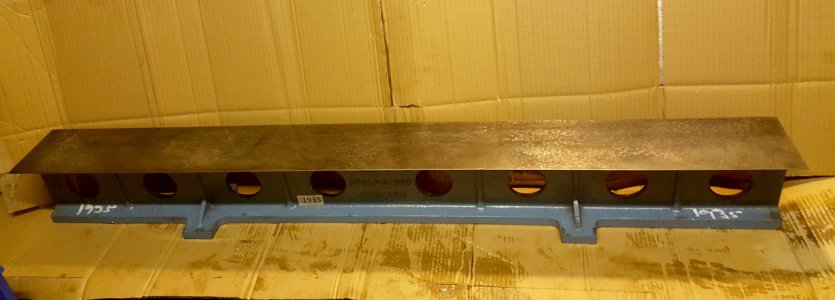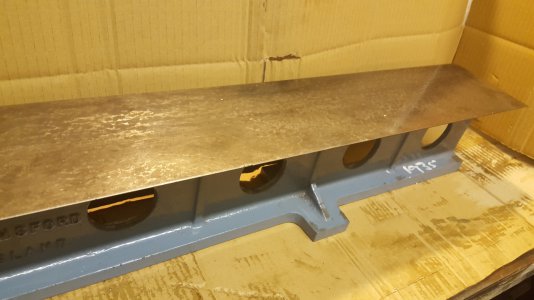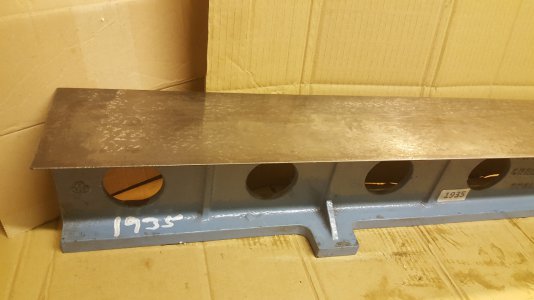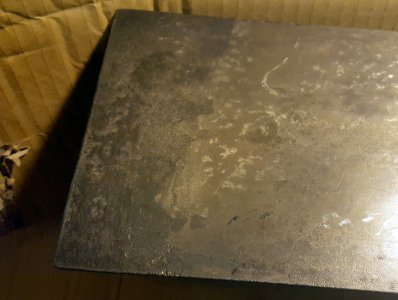- Joined
- May 27, 2016
- Messages
- 3,479
It arrived today wrapped up in an extravaganza of thick cardboard, miles of brown plastic sticky tape, and strapped down onto a pallet. All except the last 5cm or so at one end seems usable. I can see the scrape marks everywhere, and it's now the straightest thing I own.
It has dovetail bevels!
Underneath, it stands on three little steel balls set into the casting. One thing that I don't remember being in the description is that one edge is 45° beveled on the underside, and the other edge is beveled at what looks like 30°.
The rusty end.
A bit tragic, but the last two inches at one end seems to have been left exposed. Once the rust is knocked off, the pitting looks too deep to fix, unless it can be repaired with epoxy, and scraped back in. To do anything to the straight edge as a whole will require a granite at least 48" diagonal, but I may not need to do that yet. The rest of it looks OK to check out the ways on a 36" South Bend.
It's heavy!
I can just about pick it up, but not so easily move it about. I protected it at the edge of the (steel) benchtop with cardboard, and then lifted the other end. Clearly I have to contrive some sort of "dangle it" arrangement to be able to gently set it onto, or up against, anything one wants to check out. Given I can actually pick up the 36" South Bend lathe bed, I kinda wondered if it would be easier to dangle the bed onto it. Duh! Silly notion, surely!
So, such as it is, I now have a main reference for most of what I want to be doing. One day, it might get a refurbishment makeover, but for now, I can just use it.
I don't know how deep that rust pitting is on the end, and I am open to any suggestions about what one does about stuff like that, short of a regrind and a scraping in.




It has dovetail bevels!
Underneath, it stands on three little steel balls set into the casting. One thing that I don't remember being in the description is that one edge is 45° beveled on the underside, and the other edge is beveled at what looks like 30°.
The rusty end.
A bit tragic, but the last two inches at one end seems to have been left exposed. Once the rust is knocked off, the pitting looks too deep to fix, unless it can be repaired with epoxy, and scraped back in. To do anything to the straight edge as a whole will require a granite at least 48" diagonal, but I may not need to do that yet. The rest of it looks OK to check out the ways on a 36" South Bend.
It's heavy!
I can just about pick it up, but not so easily move it about. I protected it at the edge of the (steel) benchtop with cardboard, and then lifted the other end. Clearly I have to contrive some sort of "dangle it" arrangement to be able to gently set it onto, or up against, anything one wants to check out. Given I can actually pick up the 36" South Bend lathe bed, I kinda wondered if it would be easier to dangle the bed onto it. Duh! Silly notion, surely!
So, such as it is, I now have a main reference for most of what I want to be doing. One day, it might get a refurbishment makeover, but for now, I can just use it.
I don't know how deep that rust pitting is on the end, and I am open to any suggestions about what one does about stuff like that, short of a regrind and a scraping in.




Last edited:
